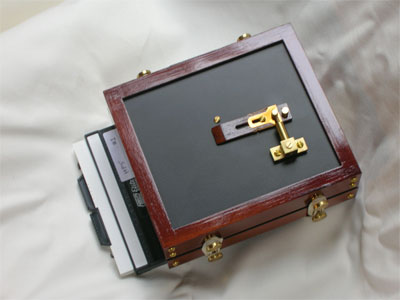Google Analytics
Glossary: Equipment and Ideas Defined
This glossary is an ongoing attempt to describe our working methods, equipment, ideas and local jargon. As such, this page will likely never be complete.
25 June 2009 - First entry: Our Cameras.
9 Jan 2010 - More cameras.
Click here for Russel Kwan and Wendy Kwan Black and White Fine Art Photography Home Page.
Our Cameras
All the cameras listed here belong to us, and we use them all. Some of them have very special applications, but most are general-purpose machines that happen to do at least one thing particularly well.
Canon F-1
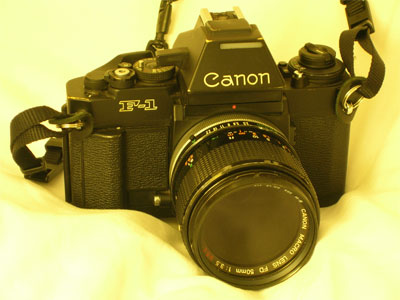
Wendy's principal camera, this workhorse system camera was developed for combat photographers serving in Vietnam. This, the last version, has been out of production since 1989. Its full-metal-jacket construction of brass and stainless steel makes it nearly indestructible - it could literally stop a bullet. Canon built fleets of FD manual lenses to serve this camera, and many of those lenses have optics that equal or surpass the quality of more modern lenses. All of our F-1's are equipped with the 100% view AE finder (as shown). We don't use the motor drives that snap onto the bottom of the camera. The camera has an electronically governed, titanium shutter, which still works via a mechanical backup if the battery fails. The prism and screens are easily user-removeable, allowing easy access for cleaning. The system is amazingly reliable - our oldest one dates from 1977, and is still in service.
Wendy finds this camera ideal for her way of handheld moving and shooting - where the camera is an extension of her body, light, invisible, maneuverable.
There are few downsides to this camera. Its shutter is loud and distinctive, which makes it less than stealthy. It is a little heavy, but still much lighter than most DSLRs.
Fotoman 45PS

Russ' street 4x5 camera, this is a modern interpretation of a World War II aerial surveillance camera. All the parts, other than the quaint wooden handles are milled from solid blocks of aluminum, yielding an almost indestructible large format camera. Sadly, Fotoman ceased production in 2009, and there are not all that many of these beauties in the world.
Shown here, the Fotoman 45PS has a Schneider Sironar 180mm (slightly longer than normal) lens mounted; a Toyo viewfinder that was machined to fit locally in Vancouver by the amazing Steve of Steve's Cine Services; and Fotoman's auxiliary rangefinder (the little thingie on the accessory shoe, top right).
The camera also comes with a ground glass for critical focusing, when the rangefinder is deemed not accurate enough (although for the street application, I've never needed the ground glass).
This camera really does work well handheld, and it is so rugged that I'm happy to take it practically anywhere. It also has practically no setup time, especially if you leave a film holder in the camera, ready to go.
Drãnoflex
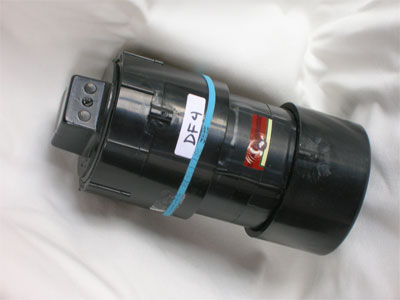
Russ' homemade, nearly indestructible 4x5 inch large format pinhole camera, fashioned entirely out of plastic plumbing parts, a beer can, electrical tape and a rubber band. For complete instructions on making Drãnoflex, click here for the full article.
Holga 120N
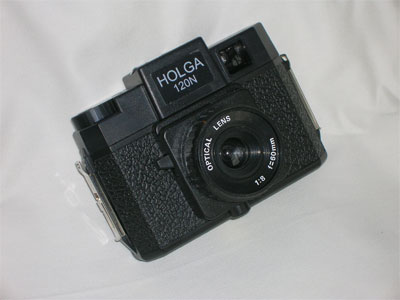
Wendy and Russ have been working extensively in 2009 with these little toy cameras. Made in China, these medium format cameras use 120 film, offer 6x6 and 6x4.5 cm formats (via a little insert thingie), a crappy plastic lens, and virtually no camera controls other than a "guesstimate" focusing system, one fixed shutter speed (which varies from sample to sample - Russ' is about 1/125 and Wendy's is about 1/140), and shutter "B".
Wendy has been working with multiple exposures and shooting while rollerblading, among other things.
Russ has drilled holes into his Holga, and lately has converted it into a Slit-Scan camera to make oddly distorted panoramics. For more information on slit-scan modified Holga, click here for the article.
Mamiya 645 Pro TL
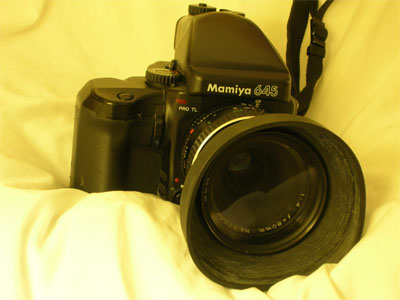
This is one of the last incarnations of Mamiya's 6x4.5cm medium format studio system camera. With interchangeable film backs, different finder and screen options (the AE finder is shown), motor drives (the smaller of the two drive systems is shown, grips, TTL flash (not shown) and a good complement of lenses, this is a very flexible camera system, while being much smaller and lighter than its big brother, the RZ67.
For all that flexibility, we still find this camera pretty heavy, very loud (the shutter and motor drive can be heard in the next town), and less portable than one might like. Russ once carried this camera on a bike trip in Europe for 12 weeks, and is not anxious to repeat the experience.
Mamiya 7II
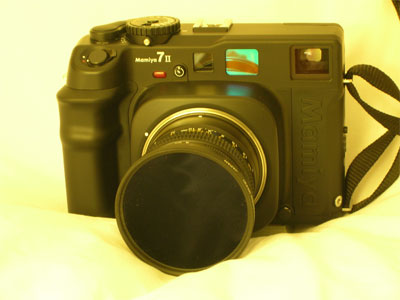
Russ' principal camera, the Mamiya 7II is a medium format 6x7cm rangefinder camera that blends the large negative size of medium format with a camera body that is not much bigger or heavier than a 35mm SLR. This camera is fast to operate, the lenses are of amazing quality, it's incredibly quiet (when Russ first started using this camera, he couldn't tell when the shutter fired, and that was very confusing) and most people think its a toy anyways, so it's remarkably inobtrusive.
There are always tradeoffs, and the 7 has some: there are a very limited set of lenses available, and we have the most-useable ones: 65mm, 80mm and 150mm. The lenses are also quite slow (f/4), which keeps the weight down, and alleviates small deviations in rangefinder accuracy. The lenses can't focus very close, and rangefinder parallax becomes a problem in close, anyways. The rangefinder itself can go out of calibration, although field recalibration is possible, albeit nerve-wracking (Russ once did this in a hotel room in Thailand).
Mamiya RZ67 Pro II
The RZ67 has been the dominant studio camera worldwide for decades, and it truly is a workhorse system camera with a huge lens lineup (shown here with a 90mm), multiple choices for viewfinder (shown here with the lightweight waist-level finder), grips (shown here with the electronic cable release L-Grip), backs (shown here with the standard 120 6x7 film back) and viewing screens (ours has a grid screen).
It is very heavy (almost 10lbs as shown) and bulky, and so is barely practical to hand-hold. I find the film loading very clumsy, and hard to do in the field without somewhere to set the camera down. The bellows is delicate and sometimes in the way, so care must taken not to damage it, or the plastic gears that drive the rack-and-pinion steering mechanism (we've replaced the original plastic gears with much more rugged brass ones).
That said, the camera has a revolving back, which allows a portrait-to-landscape mode with a flip of a switch and a twist of the back. Some find the ground-glass focusing to be difficult, but with a little practice it is actually quite easy, even in relatively dim light. The mirror is NOT instant-return, so you don't get your viewfinder back until you advance the film. Flash sync is on the lens via X-sync cable or an oddly left-side-mounted hot shoe - but the leaf lens allows flash sync up to the max shutter speed of 1/400.
Mamiya C330
I became interested in very-low point-of-view shooting sometime in 2009. and hit upon the Mamiya C330 as a vehicle to experiment with that kind of work. At the time, C330's were cheap and plentiful on eBay, and with a little patience one could find what I call "Doctor" cameras - a camera owned by a doctor, lovingly stored unused on a shelf for 40 years, and then sold on eBay to make room for a Nikon DsomethingX that will sit unused in the same spot on that shelf for the next 40 years.
One of the great things about the Mamiya TLRs is the large number of interchangeable parts available for them, including lenses, viewing screens and finders. I'm using the waist-level finder, and the most modern lenses (identifiable by a blue dot on the cocking lever handle), and they are very good. Shown here are the "S" (most modern) and "F" (second-most-modern) models, equipped with 65mm and 55mm "blue dot" lenses.
These little cameras shoot 6x6cm negatives and are terrific performers - easy to hand-hold, easy to keep in a bag, and very simple to operate. There is no on-board lightmeter, though.
Mamiya C3
This is the first of the Mamiya "C" cameras I acquired. It is very similar in design to its more modern C330 siblings, but has fewer idiot proofing features - which makes it a great camera for experimental photography. The shutter must be cocked by hand - which can cause some confusion, and there is no shutter release on the front - only a rather inconvenient lever on the side to fire the shutter.
Revere 33
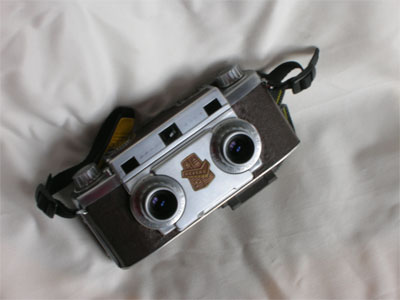
An old friend from high-school, Todd Belcher, gave us this camera from his personal collection. Circa 1955, it makes 20x24mm stereo pictures. It still works perfectly, the rangefinder is accurate, and the shutter just a little bit slow. Todd also gave us a few viewers that can be used to see the results in stereo - the 3D pictures are amazing. Can't figure out what to do with this camera yet, so it remains a curiosity for now.
Sinar P2
This is the biggest, craziest and most extensible system camera in our studio. It has both 4x5 (as shown) and 8x10 backs, is currently extendable to 42 inches of bellows draw (shown here with 24 inches of rail). The P2 features zero-detented, fully geared, independent, and yaw-free swings, tilts and shifts on both standards. There are about a zillion accessories available for practically everything I can think of - but there's no real need for much of it. We use the reflex finder and viewing hood (as shown), and Jim Galvin of Galvin Cameras in Sacramento, CA machined the lensboard adapter (as shown) so our lenses that are normally on Wisner boards (the cool wooden ones) can be mounted directly on the P2.
The P2 can do most anything one could possible ask a view camera to do, but it's not very portable. In fact, it's a beast that requires a fair amount of time to set up and tear down, and a lot of room to store - and it's definitely tripod-bound.
On the other hand, it's Swiss-made precision gives it the fastest and most positive handling characterisitics of any view camera I have used.
Super Ikonta A
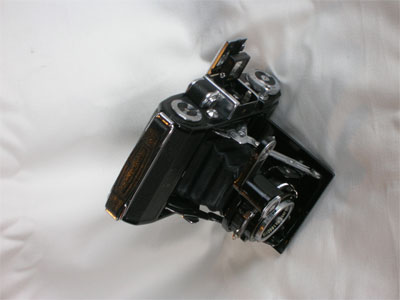
An old friend from high-school, Todd Belcher, gave us two of these cameras from his personal collection. One is circa 1927, and the other circa 1948. Both have Schneider Tessar type lenses, the 1927 one is uncoated and the 1948 one is single coated. Both look almost new, and work perfectly, rangefinders and shutters still accurate and bellows still light-tight. The cameras make 6x4.5cm negatives from medium format 120 film, and fold up small enough to fit in a pocket. When folded, the all-metal clamshell is pretty much bullet-proof. It's pretty cool to be able to walk around with a medium format camera in a pocket.
The lenses take a bit of getting used to, the uncoated optic flares like crazy, and the single-coated optic a litte less so. I'm starting to use the flare as a feature, but that is taking some practice. I've used these cameras out in the street, and they surprisingly don't attract much attention, and they are simple and quiet to operate. Of course, they can be made to disappear into a pocket in a heartbeat.
Wisner Expedition 4x5
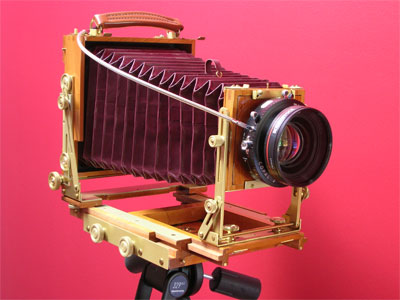
This is our 4x5inch large format field camera. It looks old, but it isn't - it was made by Ron Wisner in 1999. This camera is made of American Cherry wood (used for its unusually excellent dimensional stability, lightness and strength, not to mention beauty). The fittings are machined brass, and the bellows is leather, making for a very stable, durable (when folded) and flexible field camera. It has a long bellows draw of 22 inches, which allows the use of quite long lenses - Russ uses a 420mm lens on this camera.
As a field camera, this is pretty much everything one needs: full large format camera movements both front and rear, long bellows draw, a very stiff chassis, under 3 pounds net weight, and it folds quickly and compactly into a very strong package.
One unexpected downside: the camera is so unusual and striking that it gathers crowds - fast. I've set it up on a seemingly untravelled mountain road, only to look up to see I've gathered a crowd of about a dozen people, all wanting a look through the ground glass. I don't know where they come from, but they do come fast.
Zero Image 4x5 Pinhole Camera
A Chinese-made 4x5 large format pinhole camera. These are relatively low-cost and very flexible: the camera consists of a number of frames, a front and a back. Adding frames makes the camera deeper, giving a longer focal length, and therefore a more telephoto result. The front contains a turret with a number of different pinholes that correspond to the available focal lengths. In addition, the turret has a set of "zone plates", which are precision diffraction circles that behave something like a pinhole, but softer and faster. The whole thing (including the film holder) is held together with rubber bands. The contraption shown on the front is the shutter system which permits the fitting of a cable release. There are tripod mounts for both landscape and portrait mode shooting. In all, a very well thought out, simple and flexible way to explore pinhole photography.




